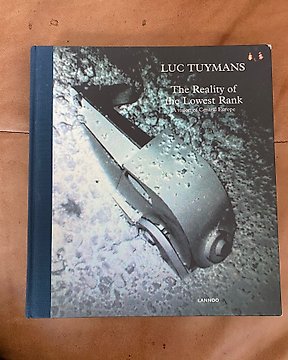
Luc Tuymans - The Reality of the Lowest Rank - 2010
N.º 81472497

N.º 81472497

Martin Parr, Gerry Badger
"Photographers have been making photobooks--bound collections of their works--ever since the birth of photography in the early nineteenth century; This publication tells the story of photography via the history of the photobook, revealing the ways in which photographers have influenced each other's work through their books, and consequently how their use of photography has developed over time ... This publication explores more than 200 photobooks through 750 colour illustations, detailed captions, and an illuminating text written by the photographer"
From Street Life in London to Hiroshima, from The Royal Mummies to Perspective of Nudes and The Sweet Flypaper of Life, photobooks encompass a tremendous diversity of subjects and styles. While some of these illustrated volumes are famous (Eadweard Muybridge's Animal Locomotion, Robert Frank's The Americans), many others are known only to specialists. The Photobook: A History offers an engrossing survey of this art form, beginning with early experiments in photography in mid-19yh-century England and ending with raucous Japanese photo-diaries of the 1990s. The scope of this handsomely designed bookthe first of two volumesis so broad that only a few pages of each photobook could be illustrated, and some of the 750 color and black-and-white reproductions are quite small. But the incisive commentary by British photographer Martin Parr and photo critic Gerry Badger opens up new worlds of visual information. The authors provide essential grounding, not only in the history of photography, but also in the artistic and social movements that influenced the look and content of photobooks. In the 19th century, the object was to collect and to classify, whether the subject was a foreign landscape, a war, the surface of the moon or the manufacture of bread. Conversely, 20th-century photobooks are often frankly subjective, drawing on movements ranging from surrealism to the Beats. Yet a quasi-scientific approach could result in poignant imagery (as in Facies Dolorosa, a study of the faces of seriously ill people), and artistic subjectivity could yield bitter truths (Helen Levitt's A Way of Seeing, images of poor children in New York). Describing photobooks of the polemical 1930s as "the great persuaders," Parr and Badger remark that the best documentary work demonstrates an awareness of the ambiguities and contradictions inherent in the medium. Although we tend to think of propaganda solely as the product of totalitarian regimes (see "Long Live the Bright Instruction," a Chinese tract featuring unnervingly happy workers), the authors remind us that photobooks celebrating the American way of life often naively ignored the complex socio-political forces that underlie a sentimental or cheerful scene. The final chapter, devoted to postwar Japanese photobooks, vividly illuminates the cocktail of hedonism, rage and despair that makes these volumes extraordinary visual documents. --Cathy Curtis
From The New Yorker
Parr, an influential British photographer, admits to an obsession with collecting photobooks, and this sumptuous collection intends to establish the genre's importance in disseminating photographic styles and trends. Alongside acknowledged masterpieces by Walker Evans, August Sander, and Nobuyoshi Araki, Parr and Badger consider many less well-known examples. There are art books like "Paris," by Moï Ver, a Lithuanian contemporary of Brassaï didactic works such as the German medic Hans Killian's sixty-four images of suffering patients; and outright curios like Owen Simmons's 1903 "The Book of Bread" (forty life-size portraits of slices of bread). Sections on Soviet photobooks of the nineteen-thirties and Japanese photobooks of the nineteen-sixties point to two particularly fertile periods. One hopes that publishers may be spurred to reprint some of these exceptional books.
Cómo comprar en Catawiki
1. Descubre algo especial
2. Haz la puja más alta
3. Paga de manera segura